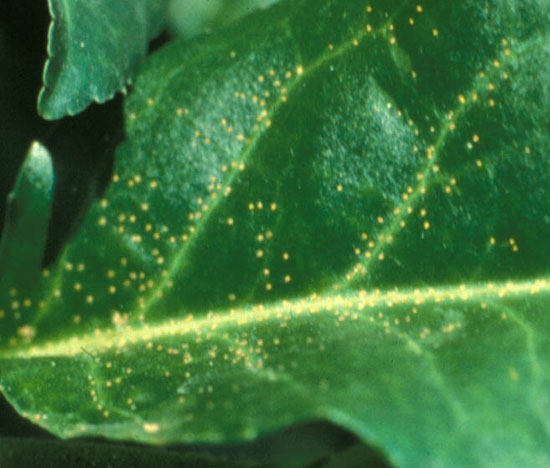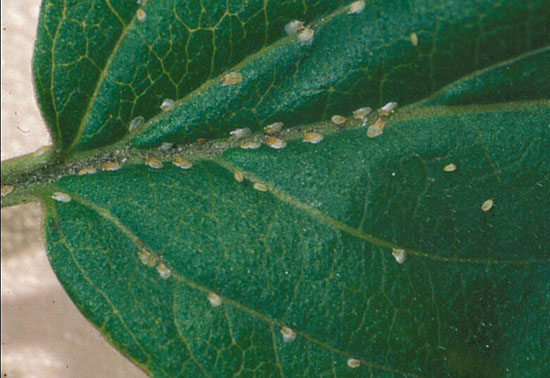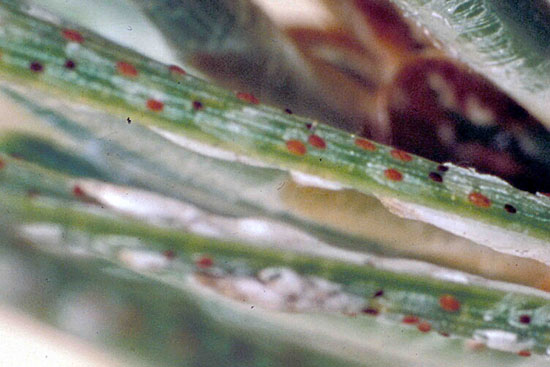Issue 3, May 7, 2010
Armored Scale Insects
There are a number of armored scale insects that are producing crawlers at this time of year in Illinois. Crawlers are the first stage nymphs and are very susceptible to contact insecticide sprays. Older nymphal stages and the adult secrete a waxy material that covers and protects them from drying out, predators, and contact insecticides.
Armored scales are sucking insects, feeding on the contents of cells. As a result, they do not produce honeydew and are not as easily killed with systemic insecticides as are soft scales that feed on phloem contents. That's why many systemic insecticide labels list armored scales as being suppressed rather than controlled.
Scale crawlers typically crawl on the leaves and stems of the host for a couple of weeks. Once they settle down to feed, they will molt to the second nymphal instar that secretes the protective waxy covering. Scout for crawlers by looking closely for tiny insects crawling on the leaves and stems. Although they are considerably smaller than the head of a straight pin, they are easy to see with the unaided eye if you look close. They are easier to see on the leaves. Even so, a hand lens is useful to be sure that you are seeing scale crawlers. Wrapping black electrical tape, sticky side out, around stems makes a good sticky trap to aid detection. The light-colored crawlers are more obvious on the background of the black tape.
The armored scales that are susceptible to control at this time are as follows.
Euonymus scale should be present as crawlers throughout Illinois. Look for lemon yellow crawlers on the foliage and stems of evergreen and deciduous species.

Euonymus scale
Winged euonymus scale, also known as Euonymus alatus scale, crawlers should also be present in southern Illinois. This scale is present only on winged euonymus or burning bush and is similar in size and shape to oystershell scale.
Oystershell scale, brown race, is still susceptible to control in central and northern Illinois. This race will be on apple, dogwood, and poplar. Scout for the gray race to see if the gray crawlers are still present in southern Illinois and to see if they have emerged yet in central and northern Illinois. The gray race occurs on lilac, ash, willow, poplar, and maple. Adult oystershell scales are about one-eighth inch long. They are curved and slender with one end being larger than the other. The crawlers are gray.

Oystershell scale
Pine needle scale produces dark red crawlers which are present and controllable in central and northern Illinois. They may still be present in southern Illinois. Adult pine needle scales are one-eighth inch long, white, and slender. They are common on the needles with heavy infestations making the tree look like a flocked Christmas tree. In addition to pines, this insect is also common on spruce and hemlock.

Pine needle scale
Armored scales cause dieback and even plant death when numerous. Frequently, armored scale populations are patchy, being very heavy on a few branches and almost absent on others. If the plant is relatively healthy, it may be useful to prune off heavily infested branches before treating. This will aid in achieving control of the remaining insects.
Although many scale species can be controlled with dormant oil sprays, oystershell scale and pine needle scale overwinter as eggs under their mother's protective cover, making them very resistant to that control method.
Because scale crawlers are so susceptible to contact sprays, a variety of insecticides are effective against them. Insecticidal soap and summer spray oil are effective, but very good coverage is needed and repeat applications every few days may be needed. Acephate (Orthene), acetamiprid (TriStar), bifenthrin (Onyx), carbaryl (Sevin), and cyfluthrin (Tempo) are effective and longer-lasting, requiring only one retreatment about ten days after the first application. Let your scouting and sticky traps be your guide as to whether and when repeat applications are needed.
The sucking mouthparts of scales are so long that they help keep dead scale from falling off of the plant. Control efficacy can be determined by flipping over individual scale covers while observing with a microscope or hand lens. If the soft-body of the scale under the cover has dried up or is missing, the scale is dead. Live scale are soft and plump under the scale cover. An easier way is to check for infestation later in the year on first year twigs.--Phil Nixon
Author:
Phil Nixon